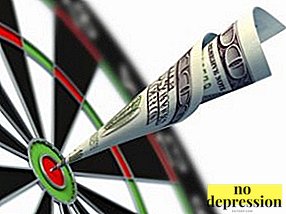Human activities are governed by his motives and consciously set goals.
In their absence, the motives would be subordinated only to emotions, which bear the short nature of time, and actions would be erratic.
What are motives and goals? What function do they perform in a person's life?
Motives and goals - what is it?

Motive - this is what motivates a person to some kind of activity, which is aimed at satisfying the need for something.
When a person has a motive, he has the energy to achieve some specific results, the implementation of actions.
The motive can also be directed not only to the implementation of any activity but also to abandon her.
The motive can not always be explained by itself, it is understandable only when considering the factors that make up the general mental structure of a person - he is an impulsethat makes a person move towards a goal.
The combination of sustainable motives that orient the activities of the individual determine the orientation of the personality, its tendency towards life goals.
purpose - this is what a person consciously aspires to, the result of his activities aimed at achieving a certain result. It may also be the process of any activity, involvement in it.
In order to set a goal, first of all, a person must have motivation for it - for example, self-assertion, wealth, self-realization. Moreover, the goal is often defined by several motives.

Goals also motivate people to act.
At the same time, the more specific they are, the greater motive force they have.
General, unconcreted targets are weakly stimulated to any action.
What are they determined by?
Motives and goals reflect the needs of the person, which force people to look for ways to meet it.
Abraham Maslow, a famous American psychologist, presented the following basic needs that define the goals and motives of the individual:
- At the first place man’s concern for his physiological needs — food, sleep, sex, maintaining health.
- In meeting the primary needs the person will be engaged in their safety and comfort - prevention of health, home improvement, consistency and safety of the conditions in which he lives.
- Being a social being, in the third stage a person will strive to build interpersonal relationships - communication, friendship, joint activities, caring for another person, etc.
- With the normalization of social needs of the individual will need to achieve a certain attitude in society - respect, recognition, career growth, appreciation of their own actions.
- At the last stage spiritual needs are revealed - the process of knowledge, creativity, self-expression, self-development of the individual.

Respectively, first of all, people tend to meet the physiological needs, and only after they are realized, spiritual needs arise.
Some needs are permanent. - the person will always strive for their satisfaction. Others can occur periodically, and some - to be non-permanent, short-term - after they are satisfied, a person forgets about them.
Also, a person may have several needs at the same time, which can cause a conflict of motives.
Types and functions
The following motive functions are distinguished.:
- incentive - the urge to any action;
- guide rail - at the same time the motive directs the action of the person;
- goal-generating - the motive leads to an action that is aimed at meeting a particular need;
- semantic - giving the action of subjective importance and importance.

The main function of the motive is the motivation and direction of a person to any activity. Wherein not all motives will be equal - they will be in a certain hierarchical system.
Also, some of them may not be realized by man. In the process of human activity and development, some motives may disappear and others may be born.
Motif types are classified according to the following criteria.:
- Actual and potential. Actual ones are those that encourage current actions to be performed - for example, a person works in highly paid work, lives in a comfortable apartment, and the main motive is maintaining the current situation. Potential - those that are able to induce action in the event of a change in the situation - the same person, under the threat of reduction, will be motivated to look for another job or development in another direction.
- Leading and minor. The motivational sphere has a hierarchy that can be clearly seen when a person has a conflict of motives. For example, friends made an offer to spend the weekend fishing, while this weekend was taken overtime work at home. As a result, the leader turns out to be the last, since the welfare and encouragement of leadership is more important than rest, which also wants to devote time.
- Semantic and motives-incentives.
At the heart of any activity there may be several motives at the same time, and the more there are, the more they are able to provoke a person into concrete actions.
For example, a person wants to get a high-paying job related to travel to other countries. The main, semantic motive will be the high encouragement of labor, the secondary, incentive motive is to expand the horizons, to communicate with new interesting people.
- By generalization. For example, you can love to listen to music in the style of rock, and you can love the works of only a certain rock band.
- Conscious and unconscious. Some motives can be clearly recognized - for example, to get some kind of education in order to find a well-paid job and get an opportunity to realize oneself. Others may not be realized - for example, arachnophobia, when a person can be afraid and avoid a small spider that is not really capable of harming him.
- Subject content:


- subject. Determine the end result of the activity - for example, build a house, buy a car;
At the same time, they can not only reflect the object, but also the attitude towards it - to take, acquire, refuse, create, save, avoid something.
- functional. For example - the need of a person in communication. This action does not have any ultimate goal. The motivation is the very involvement in this or that process. An example might be gaming activities;
- regulatory. These motives do not encourage activity, but limit it - for example, morality.
Motives of professional activity

Professional activity plays a key role in our life.
However, a poorly motivated employee will not be able to fully realize his human resource, and also bring the maximum benefit to the company where he works.
What are the motives of professional activity?
- Wages and material benefits. Often it is the monetary remuneration for professional work that is fundamental in the motivation of an employee. Every person wants to have material benefits, while spending some effort to achieve them. As a rule, employees interested in material well-being prefer to work alone to receive money for their own work.
Good results with this approach are also shown by the organization of labor, in which the size of the salary is directly proportional to the volume of work performed.
- Comfortable atmosphere and acceptable working conditions. If the employer cares about the comfort of its employees, the organization of the workplace, the effectiveness of the latter can increase significantly.
- Clearly stated tasks. Some employees prefer well-developed rules of action, when they can rely in their actions on pre-written rules. For them, it is important to act in accordance with the charter, comply with the accepted norms and demand the same from colleagues. Other employees are important greater freedom of action.
 They do not need regulations, but, on the contrary, avoid it. For them, the motivation is the ability to solve the problem by their own methods. Such employees do not like constant control over themselves, constantly strive for independence, and sometimes they specifically ignore the rules, spending a lot of their energy on it.
They do not need regulations, but, on the contrary, avoid it. For them, the motivation is the ability to solve the problem by their own methods. Such employees do not like constant control over themselves, constantly strive for independence, and sometimes they specifically ignore the rules, spending a lot of their energy on it. - Social contacts. Different workers may have different attitudes towards social contacts in the workplace. For one type of people, the motivating factor will be the ability to communicate with new people, they are immune to noise, receive positive emotions when communicating. Another type of people will be motivated by such work, which does not require communication with people - for example, control mechanisms, work at the computer - where there is no need to contact with colleagues.
- Public acceptance. Some workers have a need for their approval by the community for the work done. They do not so much focus on the amount of wages as they wish their work to be noticed by others.
Carrying out his professional tasks, a person can not only receive material remuneration for work, but also satisfy his need to be useful to society.
- Influence and power. In the professional field, you can realize your need to occupy a certain place in social status by obtaining the position of a manager. This becomes a particularly important motivational factor for people who are prone to subjugating other people to themselves. From the perspective of management, this desire is called the achievement of goals through the efforts of other people.
- Self-realization. In this case, the incentive to work is the implementation by the employee of his skills and knowledge. At the same time it motivates the very possibility of performing certain actions.
- Improvement and development. A person seeks to master new skills, he has a need for self-improvement.
The opportunity to encounter something new, to master new knowledge is also an important incentive for the work of workers.

Needs give rise to motivesthat encourage and direct a person to a certain kind of activity. Being aware of them, a person sets goals in himself, the realization of which ultimately leads to satisfaction with life and the possibility to maximize his potential.
Needs as motive of activity:

 They do not need regulations, but, on the contrary, avoid it. For them, the motivation is the ability to solve the problem by their own methods. Such employees do not like constant control over themselves, constantly strive for independence, and sometimes they specifically ignore the rules, spending a lot of their energy on it.
They do not need regulations, but, on the contrary, avoid it. For them, the motivation is the ability to solve the problem by their own methods. Such employees do not like constant control over themselves, constantly strive for independence, and sometimes they specifically ignore the rules, spending a lot of their energy on it.

